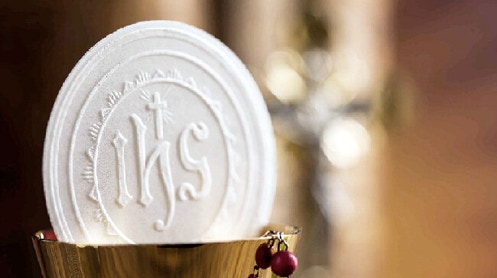


Common Objections
Common Objections
Catholic Outlook
Catholic Outlook

Catholic Outlook
Common Objections
Common Objections
__________ Recent Additions __________
Catholic Outlook
Catholic Outlook
__________ Catholic Customs __________
“Catholics worship false gods. The letters ‘IHS,’ imprinted on the communion wafer stand for the Egyptian gods Isis, Horus, and Seb.”
Gary Hoge

Wait a minute, I thought I was supposed to be worshipping Mary. Or statutes. Or statues of Mary. But apparently I’m supposed to be worshipping Isis, Horus, and Seb, three Egyptian gods so obscure even the Egyptians have never heard of them. This sounds hard to believe, but it must be true, because in his book The Two Babylons, Alexander Hislop wrote,
But let a Roman worshipper of Isis (for in the age of the emperors there were innumerable worshippers of Isis in Rome) cast his eyes upon them, and how will he read them? He will read them, of course, according to his own well known system of idolatry: “Isis, Horus, Seb,” that is, “The Mother, the Child, and the Father of the gods,”—in other words, “The Egyptian Trinity.” Can the reader imagine that this double sense is accidental? Surely not.1
Surely not. Well, yeah, actually it is. I hate to deflate such a marvelously paranoid theory, but in Christianity the letters “IHS” are just a contraction of the Greek word ΙΗΣΟΥΣ (“IHSOUS,” pronounced “Yay-SOUS”). Those of you who have a Greek interlinear New Testament will find this word used frequently in Holy Scripture, 914 times to be exact. As you may have guessed, it is simply the Greek form of the name “Jesus.” According to the 1917 Catholic Encyclopedia:
From the third century the names of our Saviour are sometimes shortened, particularly in Christian inscriptions (IH and XP, for Jesus and Christus). In the next century the “sigla” (chi-rho) occurs not only as an abbreviation but also as a symbol. From the beginning, however, in Christian inscriptions the nomina sacra, or names of Jesus Christ, were shortened by contraction, thus IC and XC or IHS and XPS for Iesous Christos. These Greek monograms continued to be used in Latin during the Middle Ages. … Towards the close of the Middle Ages IHS became a symbol, quite like the chi-rho in the Constantinian period.2
Lest you think that’s just Catholic propaganda, I found the following from Lutheran Witness Magazine,
The most common but perhaps least understood monogram often appears in Lutheran churches in the chancel or on the altar itself: “IHS.” It is simply the first three Greek characters in the name “Jesus.”3
I also found this from the United Methodist Church,
IHS are the first three letters of the name "Jesus" in Greek. This is Iota (I), Eta (H in capitalized form in Greek), Sigma (S). It is sometimes written IHC (the version of the capital letter sigma at the end of a word is C) and may include a bar over the H to indicate an abbreviation.4
I have personally seen this symbol used at Methodist, Presbyterian, and non-denominational churches. Maybe you’ve seen it in your church, too. It is obviously as much a Protestant symbol as it is a Catholic one, but hopefully you haven’t been accused of worshipping Isis, Horus, and Seb.
__________
1 Alexander Hislop, The Two Babylons, chapter IV, https://www.cbcg.org/twobaby/sect43.html.
2 R. Maere, “IHS,” Catholic Encyclopedia, Encyclopedia Press, Inc., 1913, https://www.newadvent.org/cathen/07649a.htm
3 “Monograms, Christograms, and Initialisms,” Lutheran Witness Magazine, https://witness.lcms.org/2021/monograms-christograms-and-initialisms/
4 “What do the letters IHS stand for?”, The United Methodist Church, https://www.umc.org/en/content/ask-the-umc-what-do-the-letters-ihs-stand-for
Copyright © 2024 Catholicoutlook.me
MENU